The gaming world is in the midst of a storm of innovation, bold launches, and shifting strategies. From blockbuster FPS releases to leaps in cloud gaming and AI-driven design, here’s what’s shaping the industry’s trajectory as of late 2025.
1. Battlefield 6 Aims to Reclaim FPS Glory
Electronic Arts (EA) is betting big on Battlefield 6 as it aims to compete head-to-head with Call of Duty. The game has already impressed in its beta phase, registering a record 521,000 peak concurrent PC players, and 12 million daily active users.
EA is positioning Battlefield 6 as a return to form—bringing back the class system, modern combat, and a stronger narrative campaign. The success of this launch could steer EA’s broader strategy during its $55 billion strategic restructuring.
Gamers will be watching closely to see whether Battlefield 6 can sustain momentum amid fierce competition, especially as Call of Duty faces criticism over monetization and creative direction.
2. Xbox Hardware Isn’t Going Anywhere
Rumors swirled that Microsoft might pivot away from console hardware, but the company has firmly denied those speculations. Microsoft affirmed that it is continuing development on next-generation Xbox hardware powered by AMD, including a new console and handheld device.
The recent 50% price hike for Xbox Game Pass Ultimate (and 38% for PC Game Pass) fueled speculation that Microsoft was prepping to exit hardware. But the company counters this narrative by referencing their AMD partnership and ongoing investment in cloud gaming and studio acquisitions.
While the direction is bold, Microsoft will need to regain gamers’ trust after mixed messaging and pricing decisions.
3. Cloud Gaming Leveled Up: GeForce Now’s Big Leap
Nvidia has supercharged its GeForce Now cloud streaming service with a major upgrade. Now powered by Blackwell architecture, the platform supports RTX 5080-level performance, enabling up to 5K at 120 fps and dramatically lower latency—reportedly around 30 milliseconds.
Additionally, Nvidia has expanded device compatibility (to LG TVs/monitors, racing wheels, Steam Deck, and Macs) and grown its game library to 4,500 titles. The service’s subscription tiers remain unchanged.
This move intensifies the competition in cloud gaming and raises the bar for what console-level performance should mean in streaming environments.
4. Google Play Games Gets a Profile Overhaul
On the mobile side, Google Play Games is rolling out an update to bring gaming profiles, stats, achievements, and social features into the main Google Play environment. The changes, launching globally in late 2025, integrate gaming accomplishments directly into the Play Store.
This update helps Google strengthen its gaming ecosystem—enabling better social connectivity, easier tracking, and a more unified experience for mobile gamers.
5. Razer Jumps into AI Gaming with Global Hubs
Razer is making its presence felt in the AI gaming race. The company recently opened its first AI hub in Singapore, with plans for global expansion, and is hiring aggressively (150 engineers at the Singapore branch alone).
Projects include tools like QA Copilot (for automated bug detection) and in-game assistants to optimize hardware and gameplay. The European hub will emphasize integration with Razer’s Chroma RGB, Sensa HD haptics, and WYVRN ecosystem; the U.S. hub will drive regional innovation.
Razer’s pivot into AI signals a broader shift: hardware providers becoming deeper participants in software and development pipelines.
6. Major Layoffs & Studio Changes in the Industry
It’s not all hype and progress—some studios are facing turbulence. For example, Heart Machine (developer of Hyper Light Breaker) recently announced layoffs and ended development on their ongoing project.
Meanwhile, former ZeniMax Online Studios employees have formed a new indie studio (Sackbird Studios).
These moves reflect how volatile the game development landscape can be—especially when budgets tighten and risk tolerance shrinks.
7. Big Game Remakes & Nostalgia Dominate 2025
Remakes and reimaginings are booming in 2025. Titles like Resident Evil 4 (Remake), The Last of Us Part I, Demon’s Souls, Persona 3 Reload, and Metal Gear Solid Delta: Snake Eater are among the most praised.
Because these games balance nostalgia, updated visuals, and new mechanics, they tend to draw in both veterans and new players. The remake trend is likely to continue, with future projects from Ubisoft, Square Enix, and others already rumored.
One notable upcoming remake is the Rayman series. Ubisoft is reportedly developing a remake (codename “Steambot”) slated for late 2026, and the success could pave the way for Rayman 4.
8. Noteworthy Game Launches & Release Schedules
2025 continues to be a heavy year for releases:
-
Battlefield 6 launches on October 10 across PC, PlayStation, and Xbox.
-
The Outer Worlds 2 arrives later in October.
-
NASCAR 25 is set for October 14 (console) and November 11 (PC).
-
RoadCraft released earlier in May, with a new expansion Rebuild and difficulty updates adding post-launch support.
-
Assassin’s Creed Shadows (launched March 20) continues to get DLCs—most recently, Claws of Awaji, adding story and gear content.
GameSpot, PC Gamer, and GamesRadar are tracking and updating release calendars in real time to help gamers stay on top of all the big drops.
9. AI-Generated Games & Next-Gen Engines on the Horizon
Elon Musk’s xAI team is reportedly building a fully AI-generated game to be released by end of next year. This is a bold experiment in combining generative AI and interactive storytelling.
More broadly, in the academic space, researchers are exploring Interactive Generative Video (IGV) as the backbone of next-generation game engines—where AI drives not just content, but physics, interactivity, and emergent behavior.
A companion report outlines key AI research directions in gaming: using large language models for agents, neural procedural content, surrogate modeling, and generative environment design.
Taken together, these developments hint at a future where AI is not just a tool—but a co-creator.
10. Labor, AI & Industry Agreements: The SAG-AFTRA Strike Impact
From July 2024 to mid-2025, the SAG-AFTRA strike involved voice actors and motion capture talent demanding protections around pay and AI usage.
A new agreement was ratified in July 2025, bringing AI guardrails and updated terms for digital replicas.
The resolution signals how labor, ethics, and technology are now deeply intertwined in the gaming ecosystem.
Final Thoughts & What’s Next
As 2025 rolls on, three key trends stand out:
-
Competitive AAA returns like Battlefield 6 could reshape shooter dominance.
-
Cloud and AI expansions are enabling experiences beyond hardware constraints—GeForce Now’s leap and Google’s profile integration are early signs.
-
Generative tools are pushing the boundary between player and creator, ushering in a new era of emergent gameplay.
If you’re a gamer, developer, or fan, staying current matters more than ever. Want me to produce a version tailored for a specific audience (e.g. mobile gamers, eSports fans, or indie devs)? Or turn this into SEO-optimized blog posts with titles, headings, and featured keywords? Just say the word.




